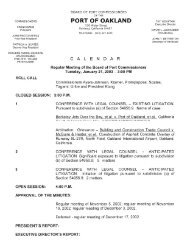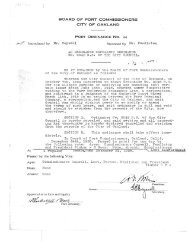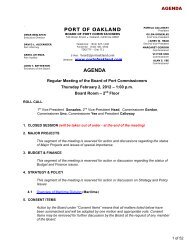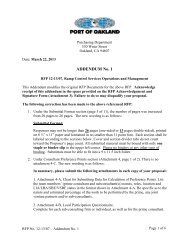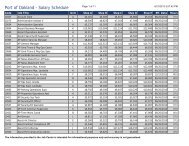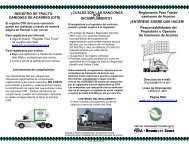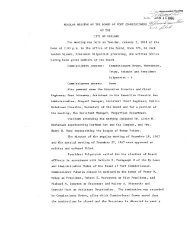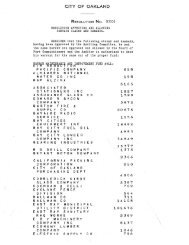Port-Wide Sewer System Management Plan(SSMP) - Port of Oakland
Port-Wide Sewer System Management Plan(SSMP) - Port of Oakland
Port-Wide Sewer System Management Plan(SSMP) - Port of Oakland
You also want an ePaper? Increase the reach of your titles
YUMPU automatically turns print PDFs into web optimized ePapers that Google loves.
personnel in the maritime division should record all relevant overflow information and<br />
dispatch response crews, as needed.<br />
It is the responsibility <strong>of</strong> the first personnel who arrive at the site <strong>of</strong> an overflow in the<br />
maritime area to protect the health and safety <strong>of</strong> the public to the extent possible. Maritime<br />
personnel are responsible for identifying the cause <strong>of</strong> the overflow, requesting additional<br />
resources as needed, taking steps to contain or divert the overflow, and taking steps to stop<br />
the overflow if possible.<br />
Following initial attempts for overflow correction and containment, Maritime personnel<br />
should contact the Environmental Compliance Supervisor for guidance on how to proceed.<br />
For spills in the maritime area, the Environmental Compliance Supervisor typically contacts<br />
a Hazardous Material Contractor to clean up and disinfect the affected area. Figure 7.2<br />
summarizes the Maritime SSO Field Response Action <strong>Plan</strong>.<br />
7.2.2.3<br />
Notification <strong>of</strong> Regulatory Agencies<br />
As noted in Section 7.2.1.3, Table 3.1 and Section 5.0 <strong>of</strong> the <strong>Port</strong> OERP provide a<br />
summary <strong>of</strong> which regulatory agencies must be notified and under what conditions. These<br />
requirements are the same regardless <strong>of</strong> the responsible <strong>Port</strong> division.<br />
However, the SSO reporting chain <strong>of</strong> communication does vary depending upon the<br />
responsible <strong>Port</strong> division. A flow chart identifying the flow <strong>of</strong> information regarding a<br />
potential SSO in the maritime area is provided in Figure 3.3 and Section 5.0 <strong>of</strong> the <strong>Port</strong><br />
OERP.<br />
7.2.2.4<br />
Section 7.0 <strong>of</strong> the <strong>Port</strong> OERP contains provisions concerning the distribution, maintenance,<br />
and awareness <strong>of</strong> the provisions presented in that document. Copies <strong>of</strong> the OERP and any<br />
amendments should be distributed to all <strong>of</strong> the maritime personnel that are heavily involved<br />
with the <strong>SSMP</strong> or OERP programs. It is also recommended that the appropriate maritime<br />
personnel be trained concerning the provisions <strong>of</strong> the OERP.<br />
7.2.2.5<br />
Emergency Response <strong>Plan</strong> Awareness and Training<br />
Section 3.2 <strong>of</strong> the <strong>Port</strong> OERP contains the emergency response procedures that should be<br />
followed by SSO response crews. These provisions are largely the same regardless <strong>of</strong> <strong>Port</strong><br />
division, and include provisions for dispatching, crew instruction, requests for additional<br />
resources, assessing property damage, field supervision and inspection, hazard materials,<br />
and crowd control, traffic diversion, and other emergency operations.<br />
7.2.2.6<br />
Emergency Operations<br />
SSO Surface Water Mitigation<br />
Discharges <strong>of</strong> untreated wastewater to San Francisco Bay are an infrequent occurrence in<br />
the <strong>Port</strong>. Should an SSO result in a discharge to the waters <strong>of</strong> the United States from the<br />
May 2010 7-6<br />
pw://Carollo/Documents/Client/CA/<strong>Port</strong> <strong>of</strong> <strong>Oakland</strong>/8239A00/Deliverables/Ch07 (FinalA)



